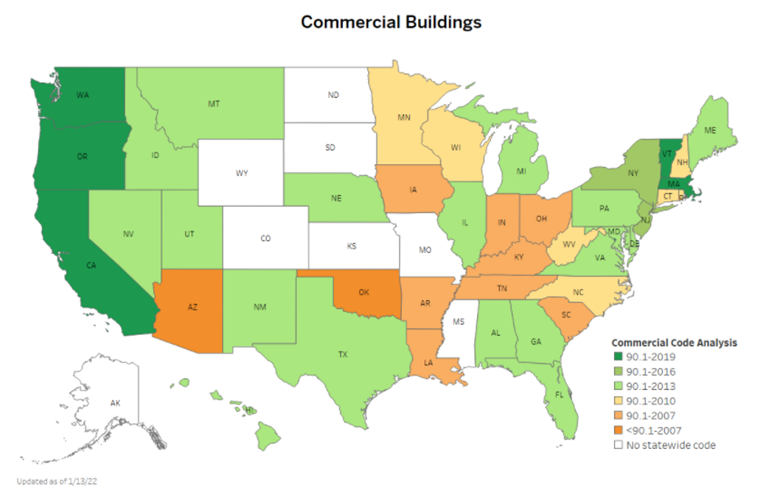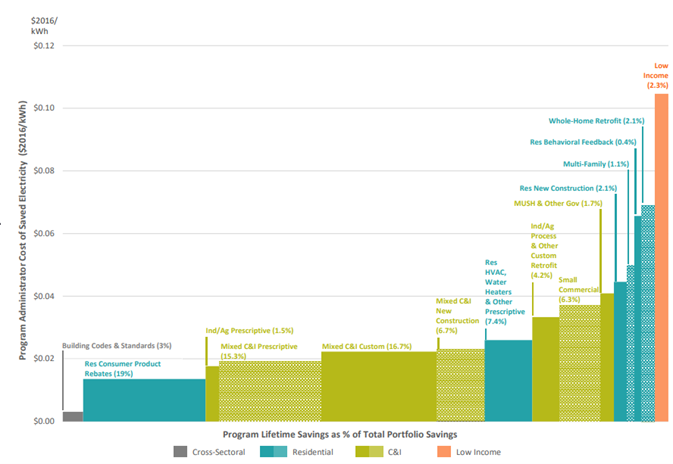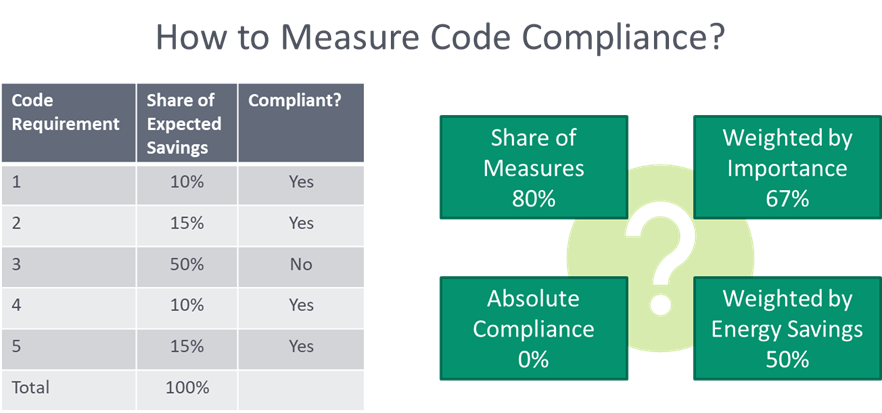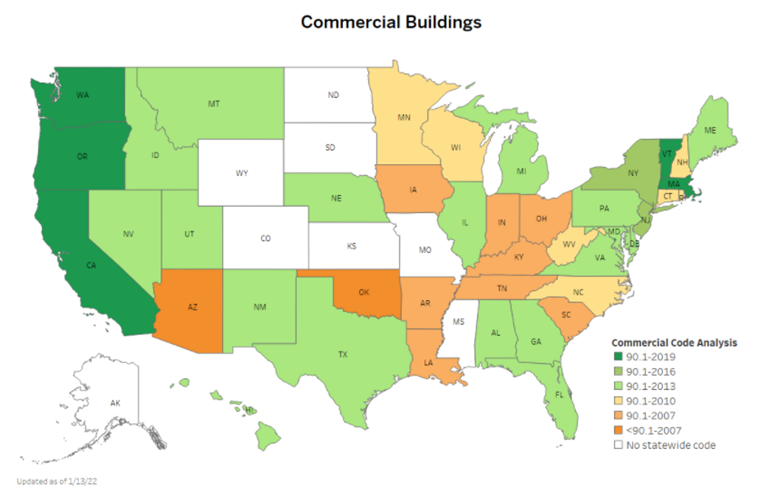Decoding Code Compliance, Part 1
Building energy codes programs are a very cost-effective opportunity for energy savings and many utilities consider these programs the next frontier of energy efficiency. The potential savings from adopting more efficient building energy codes can be significant, but only if compliance is high. But do you measure compliance and how can the same building be 0%, 50%, 67%, or 80% compliant at the same time?
Let’s dig into energy codes, what energy codes programs do, and how to evaluate their impacts.
What Are Energy Codes?
Building energy codes are local laws that establish requirements to limit the energy use in buildings, most often applying to new construction or major renovations. Two important notes: 1) Energy codes are just one type of building code, which also includes codes for fire, electrical, plumbing, etc., each of which can have their own level of compliance; and 2) while they are often grouped together, codes are different than standards.
In addition to saving energy by setting the minimum efficiency for buildings, codes are important to energy efficiency programs because they are often used as a baseline to which more efficient buildings or equipment can be compared.
States or local governments choose to adopt one of the national model codes, a modification of them, or their own local code. Two examples of the variety of adoption include Illinois and Colorado. Illinois has a state code, but also allows Chicago to adopt a more stringent local code in its jurisdiction, called a “stretch code.” Some states, like Colorado, are “home rule” states, meaning that energy codes are adopted at the local (county) level.
The most commonly used model energy codes are the International Energy Conservation Code (IECC), developed by the International Code Council, and the ANSI/ASHRAE/IES Standard 90.1 (ASHRAE 90.1) developed by the American Society of Heating, Refrigeration and Air-Conditioning Engineers (ASHRAE).[1] These model codes get updated every few years.
While nearly all states have adopted energy codes (or have home rules), they vary in the recency (and by extension, the efficiency) of the code. The map below shows the version of ASHRAE 90.1 used by each state.
Figure 1. Status of State Energy Code Adoption – Commercial (as of 1/13/22)
 Source: Office of Energy Efficiency & Renewable Energy
Source: Office of Energy Efficiency & Renewable Energy
Code enforcement is done at the local (city or county) level by the building permit office whose staff reviews plans to ensure compliance and then conducts field inspections to verify that things were actually built to plan. Often, a jurisdiction's buildings are not compliant because the local code officials do not have the resources or training to review and verify all projects.
What Do Codes Programs Do?
As seen in the little grey box on the left in the chart below, programs aimed at supporting more aggressive building codes are the least-cost energy efficiency resource. But what do they actually do?
 Source: LBNL
Source: LBNL
Programs that support building energy codes can focus on any of the following:
- Code development (support development of national model code)
- Code acceleration (support state/local code adoption process)
- Code compliance (assess compliance with existing code, conduct training of code officials and industry, provide technical assistance)
- Code enforcement (support third-party enforcement or specialized inspections)
Evaluating Code Compliance Impacts
Although code programs can support building energy codes in a variety of ways, most implemented by utilities focus on code compliance. In these, the program typically provides training and technical assistance to code officials and market actors so that they are more aware of code requirements and how to meet them. These programs can also provide additional resources for the review of complicated buildings.
For utilities/program administrators to develop code compliance programs, a framework needs to exist for them to be able to claim energy savings. The program will need to work with regulators (and hopefully evaluators) to establish agreed-upon methodologies to be able to quantify changes in compliance (and therefore savings).
So how do you measure code compliance? It turns out that there are a lot of ways and there is no standard approach. This lack of common methods holds back utilities from developing programs because they cannot claim savings. Furthermore, a common definition is needed so stakeholders can better target areas of improvement and benchmark their jurisdiction/program.
To illustrate the different ways of measuring code compliance, let’s imagine a very simple example of a building with five code requirements (see the figure below). Four of the requirements have relatively little impact on the building’s energy savings (10-15% each) and one requirement would account for 50% of savings (i.e., in terms of lost savings due to code non-compliance). In this example, the building met code for the four less important requirements and did not meet code for the more important requirement.
 One way to measure compliance is to look at absolute compliance. In this case, if the building does not meet all requirements, it does not comply with code. However, this binary choice is probably overly harsh, since the building did meet most of the requirements. Another option is to treat all requirements equally, but this does not account for the fact that some requirements will have much larger effects on energy savings. A third option would follow what the old PNNL checklist did and assign a weight from 1 to 3 to each requirement based on its relative importance. Finally, compliance could be weighted by expected savings. In our example, the building complies with four out of five requirements, but the fifth requirement is expected to account for half of the expected lost savings, so the building is considered only 50% compliant (in terms of lost savings due to code non-compliance. Depending on the method used, the building in this example is either 0%, 50%, 67%, or 80% compliant. Interesting.
One way to measure compliance is to look at absolute compliance. In this case, if the building does not meet all requirements, it does not comply with code. However, this binary choice is probably overly harsh, since the building did meet most of the requirements. Another option is to treat all requirements equally, but this does not account for the fact that some requirements will have much larger effects on energy savings. A third option would follow what the old PNNL checklist did and assign a weight from 1 to 3 to each requirement based on its relative importance. Finally, compliance could be weighted by expected savings. In our example, the building complies with four out of five requirements, but the fifth requirement is expected to account for half of the expected lost savings, so the building is considered only 50% compliant (in terms of lost savings due to code non-compliance. Depending on the method used, the building in this example is either 0%, 50%, 67%, or 80% compliant. Interesting.
Over the past decade, the Department of Energy has moved from a binary assessment of commercial building code compliance to a new method that focuses on estimating lost savings due to non-compliance (i.e., weighting by energy savings). To support this, PNNL has developed a tool to estimate compliance of buildings.[2]
Another option to using the PNNL tool is to compare the energy consumption of a building as-built to the energy consumption if it were built to exactly meet code requirements, using an energy simulation model. However, any additional flexibility or granularity this approach brings may be outweighed by the need to make sure the baseline building is modeled exactly to code requirements, which introduces opportunities for error.
Up Next: Attribution and Evaluation Challenges
In Part Two, we will explore attribution of code compliance and the need to account for naturally occurring market adoption, as well as other evaluation challenges for codes programs. Stay tuned!
[1] Ok, so technically ASHRAE 90.1 is a standard on which codes are built. But for this discussion, we can call it a code so as not to confuse it with appliance and equipment standards that set the minimum efficiency levels in products.
[2] A similar tool, called ResCheck exists for residential buildings.

